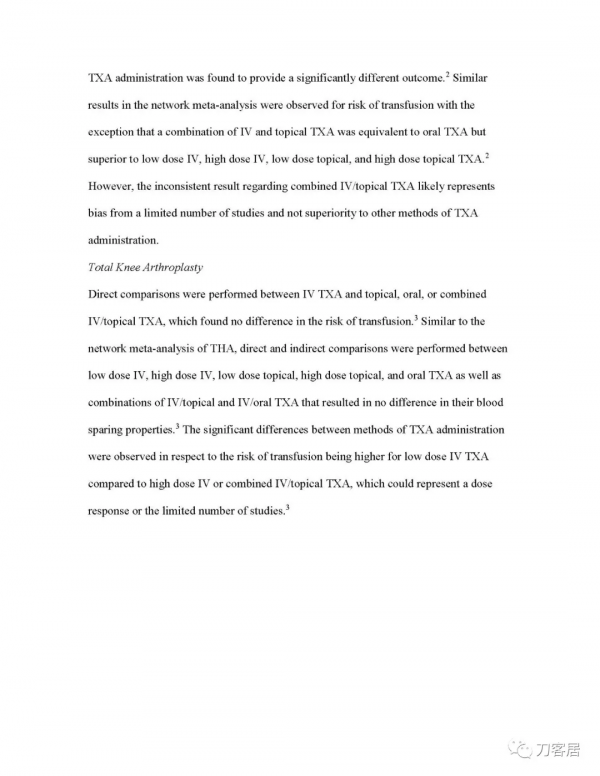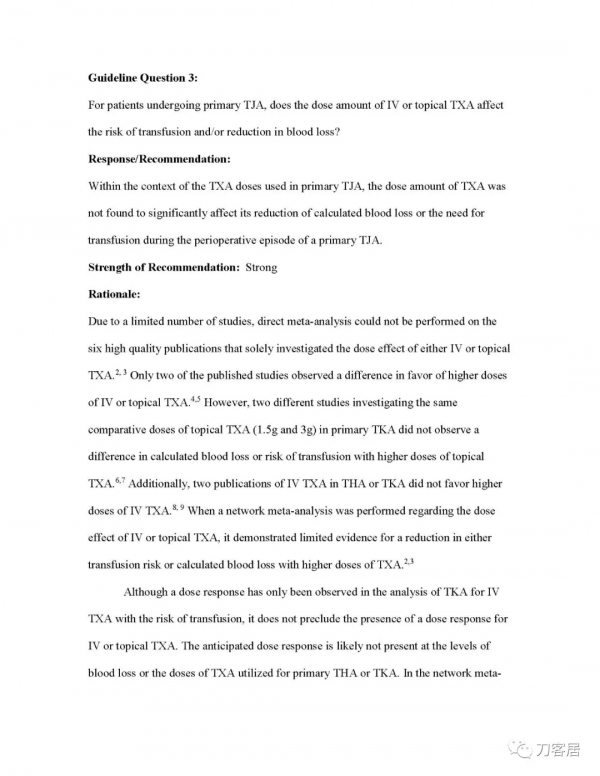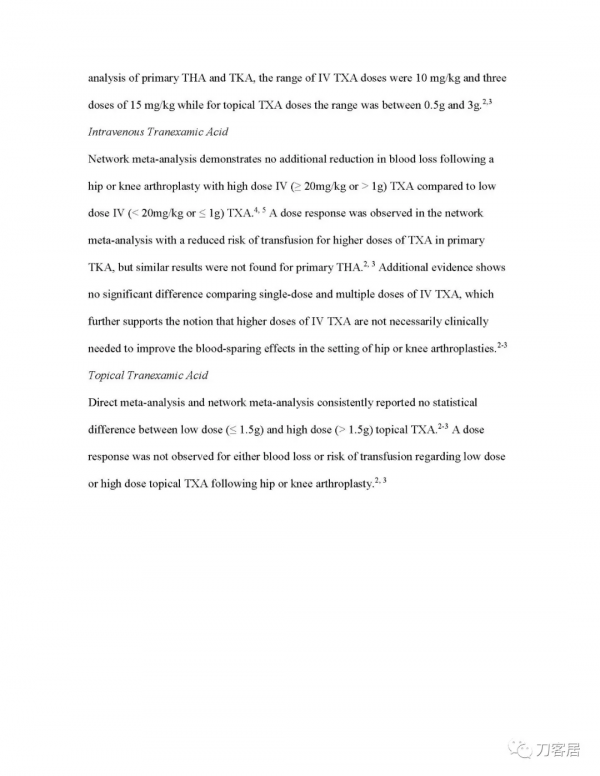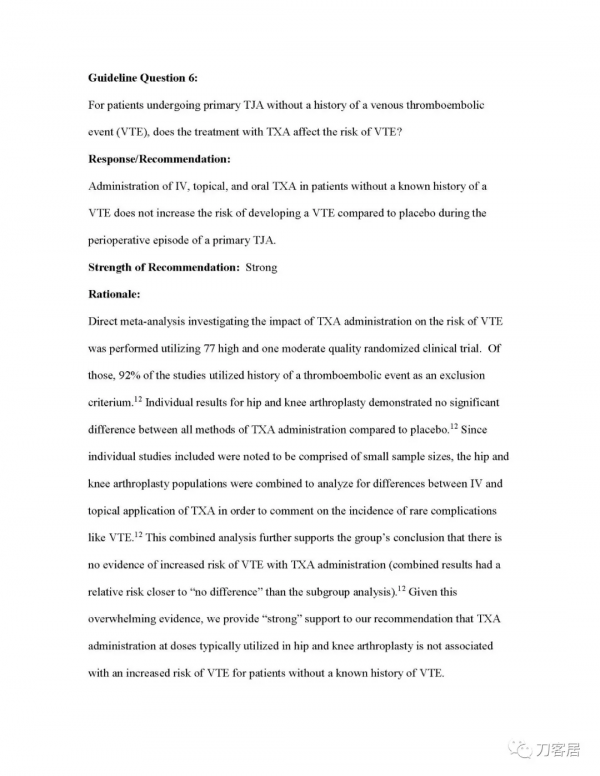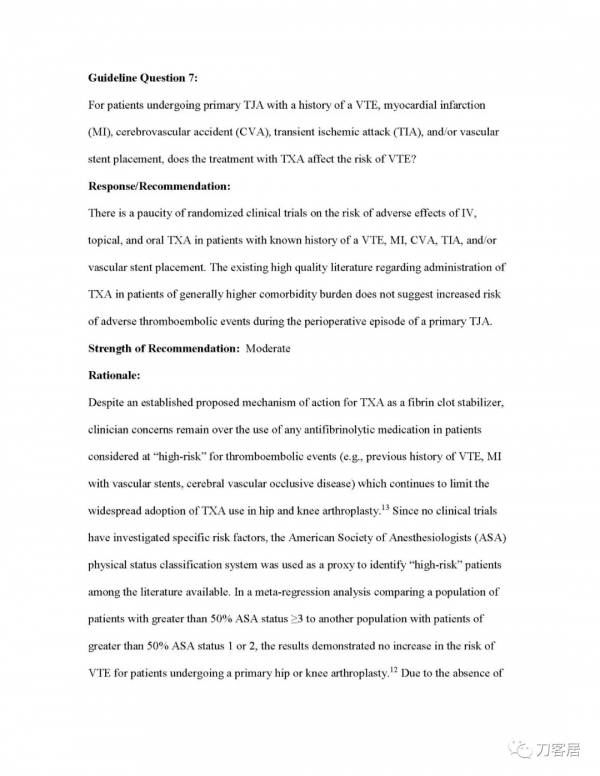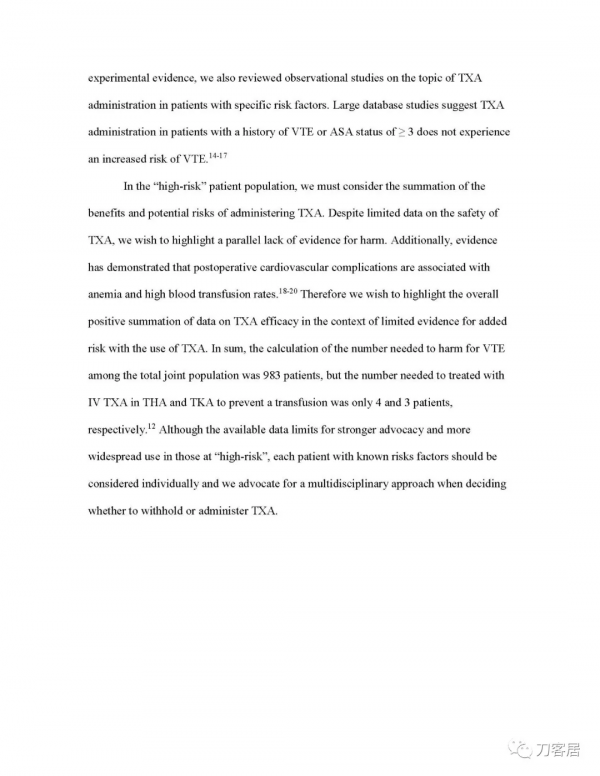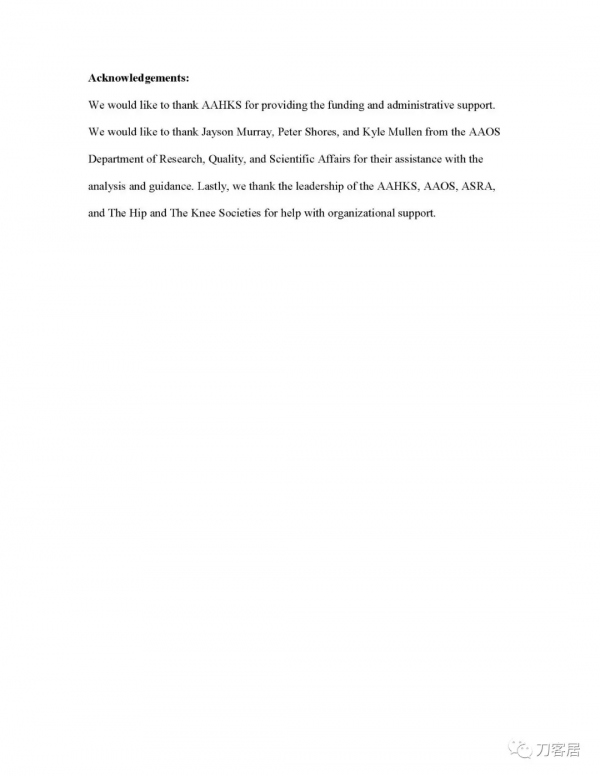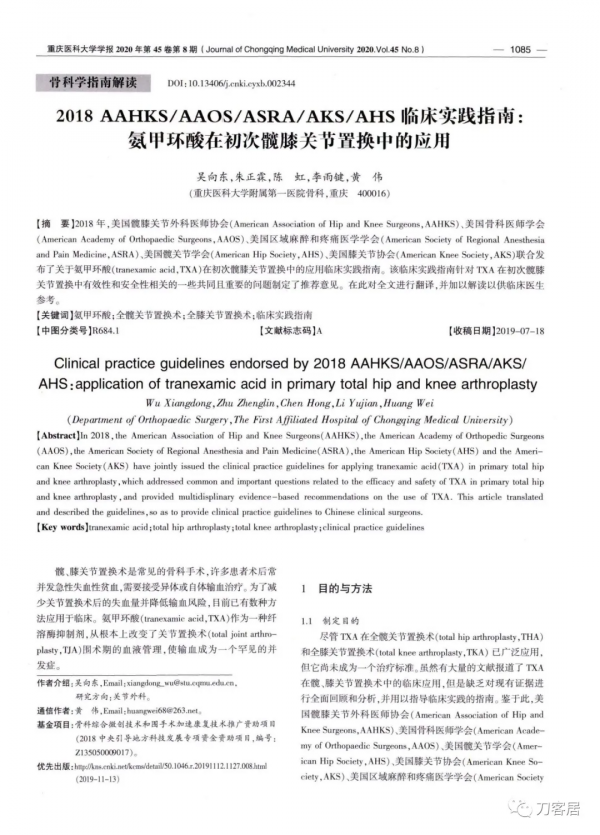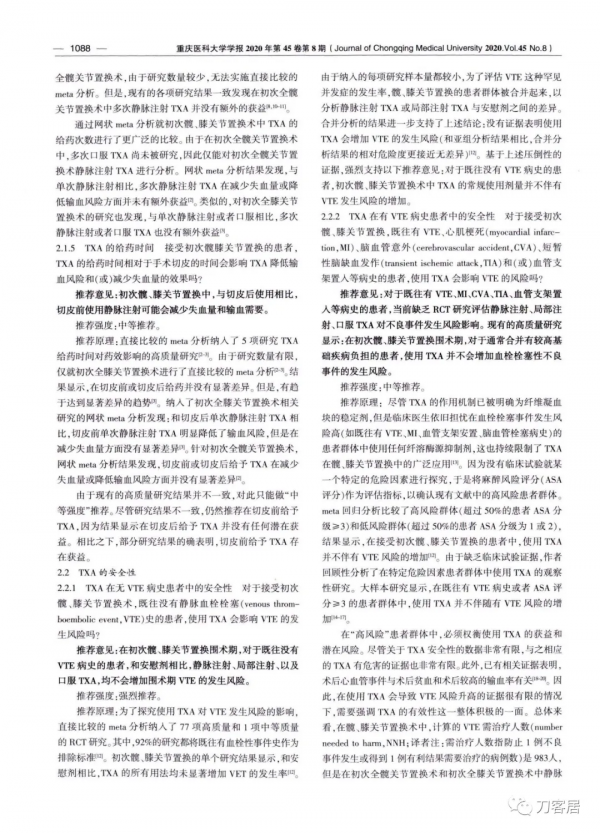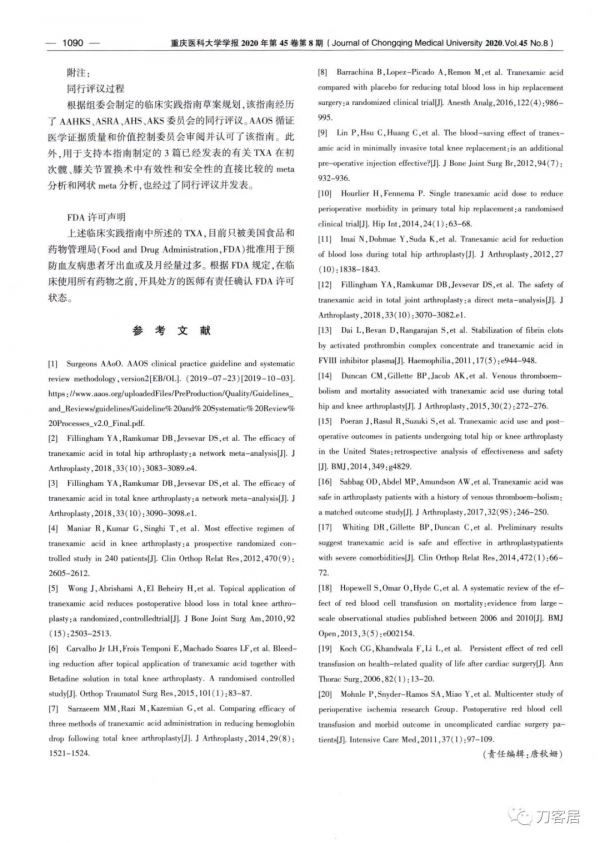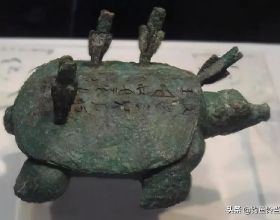氨甲環酸(TXA)在全關節置換術(TJA)中的應用:美國髖膝關節外科醫師協會(AAHKS)、美國區域麻醉和疼痛醫學會(ASRA)、美國骨科醫師學會 (AAOS)、髖關節協會(THS)和膝關節協會(TKS)共用臨床實踐指南
翻譯:劉英科,馬文龍;審校:馬真勝
編者注:氨甲環酸在關節外科已廣泛使用,但在脊柱手術中使用很少,美國FDA以及藥品說明書中,不推薦椎管內區域性使用。國外尚無專家共識或者循證指南推薦氨甲環酸用於脊柱外科手術區域性止血用。但《中國骨科手術加速康復圍手術期氨甲環酸與抗凝血藥應用的專家共識》中,對於創傷、關節和脊柱外科,都推薦了局部使用,而且《中國骨科手術加速康復圍手術期氨甲環酸與抗凝血藥應用的專家共識》中推薦脊柱外科手術區域性使用氨甲環酸的證據源於兩篇北京協和醫院發表的文獻,沒有提供國外機構或者作者的是否有脊柱外科手術區域性使用氨甲環酸的文獻:
Xu D, Zhuang Q, Li Z, et al. A randomized controlled trial on the effects of collagen sponge and topical tranexamic acid in posterior spinal fusion surgeries. J Orthop Surg Res, 2017, 12(1): 166.(北京協和醫院骨科)
Ren Z, Li S, Sheng L, et al. Topical use of tranexamic acid can effectively decrease hidden blood loss during posterior lumbar spinal fusion surgery: A retrospective study. Medicine (Baltimore), 2017, 96(42): e8233. (北京協和醫院骨科)
中科院文獻情報中心2020年將Medicine雜誌,定義為高預警雜誌,名列第3, 被國內多家醫院和高校列入黑名單,就是因為灌水(假資料)文章太多(MEDICINE雜誌被禁: https://www.360qikan.com/xunxi/5924.html)。
為了認真學習和質疑《中國骨科手術加速康復圍手術期氨甲環酸與抗凝血藥應用的專家共識》,我覺得有必要認真學習一下國外關節外科常用的指南。循證指南與專家共識不在一個層級,循證指南的價值遠遠大於專家共識,在整個指南編輯5級體系中,專家共識的可信度與個案報道同級別,屬於可信度最低的,而循證指南里強烈推薦條目屬於可信度最高的。
2018年美國髖膝關節外科醫師協會(AAHKS)、美國區域麻醉和疼痛醫學會(ASRA)、美國骨科醫師學會(AAOS)、髖關節協會(THS)和膝關節協會(TKS)共同推出的《氨甲環酸在全關節置換術中的應用:臨床實踐指南》就屬於目前關於氨甲環酸在骨科手術中應用的最高級別的循證醫學指南。
該指南的英文版網上免費可以獲取全文,國內也有學者對其進行了翻譯和解讀:
- 尹玉玲,李箭,付維力. 2018 年美國關節置換術使用氨甲環酸的臨床實踐指南解讀. 中華關節外科雜誌(電子版), 2019;13(1):93-98(華西醫院骨科翻譯版)
- 吳向東,朱正霖,陳虹,李雨鍵,黃偉. 2018 AAHKS/AAOS/ASRA/AKS/AHS 臨床實踐指南:氨甲環酸在初次髖膝關節置換中的應用. 重慶醫科大學學報,2020;45(8):1085-1090. (重慶醫科大學翻譯版)(收稿日期2019-07-18)
也歡迎各位讀者,對於我們的翻譯,與上述兩個單位的翻譯進行比對,對於我們翻譯的不足之處予以指出,我們在翻譯過程中,有些語句,為了能保證地道和流暢的用中文表達,也參考了上述兩篇解讀,應該不算抄襲。請各位批評指正。
下面就整個循證指南,我個人理解和總結如下:
- 該指南僅限於初次髖膝關節全關節置換,不涉及翻修、腫瘤和感染等關節置換。
- 使用氨甲環酸確實能夠有效降低初次髖膝全關節置換術的出血量和輸血風險。
- 靜脈、口服、區域性使用以及靜脈加區域性聯合使用氨甲環酸,效果都一樣,沒有差別,所以氨甲環酸藥品只有靜脈和口服使用兩種劑型。
- 氨甲環酸的劑量大小(大劑量或小劑量)對降低出血量和圍手術期輸血需求無統計學差異。
- 多次靜脈或口服氨甲環酸,與單次靜脈或口服使用氨甲環酸的止血效果無顯著差異。也就是說多次用藥方法無統計學意義。
- 術前使用氨甲環酸比術後給藥更有優勢。
- 無深靜脈血栓病史的患者,靜脈、區域性和口服使用氨甲環酸不會增加發生深靜脈血栓的風險。
- 合併症(靜脈血栓、心肌梗死、腦血管意外、短暫性腦缺血發作、血管支架植入病史等)較多的患者使用氨甲環酸並未增加初次全關節置換術圍術期不良血栓栓塞事件的風險。
- 現有證據並不支援氨甲環酸會增加發生動脈血栓的風險。
- 所有的條目和主要文獻,都經過了多個不同學術組織的稽核和評議,均獲得這些學術組織的認可。
- 所有指南參與者披露與該指南制定無利益相關
- 美國FDA規定,氨甲環酸只能用於預防血友病患者和月經過多患者的牙齒出血。其他用法,都是超說明書使用,醫生在用藥前有責任明確該藥的FDA許可狀態。
全文譯文如下:
引 言
髖關節和膝關節置換術是骨科常規手術,通常與術後急性貧血有關,在許多情況下需要異體或自體輸血。一些技術已用於降低術後失血和輸血的風險。氨甲環酸(TXA)是一種抗纖維蛋白溶解藥,它從根本上改變了全關節置換術(TJA)中的血液管理,輸血已不太常見。
雖然TXA已廣泛應用於全髖關節置換術(THA)和全膝關節置換術(TKA),但尚未成為標準。TXA在髖關節和膝關節置換術中的應用已有大量文獻報道,但缺乏對現有證據的全面回顧分析以提供臨床指導。因此,美國髖膝關節外科醫師協會(The American Association of Hip and Knee Surgeons, AAHKS)、美國骨科醫師學會(The American Academy of Orthopaedic Surgeons, AAOS)、髖關節學會(The Hip Society, THS)、膝關節學會(The Knee Society, TKS)和美國區域麻醉和疼痛醫學會(The American Society of Regional Anesthesia and Pain Medicine, ASRA)共同制定初次全關節置換術(TJA)中使用TXA的循證指南。該指南的目的在於透過多學科循證方法規範TXA使用,改善骨科手術患者的治療,減少實踐操作中的差異。
這些臨床實踐指南旨在解決初次全關節置換術(TJA)中與TXA療效和安全性有關的常見和重要問題。採用《AAOS臨床實踐指南和系統評價》方法,指南編輯委員會成員完成一系列直接Meta分析和網狀Meta分析,以支援臨床實踐指南[1]。與《AAOS臨床實踐指南和系統評價方法》相一致,對於每個問題,我們給予一條推薦建議,分析推薦強度,闡述給出此推薦建議和強度的理由[1]。此臨床實踐指南基於現有證據,因此隨著未來更多研究進展,可能需要進一步更新。
Introduction
Hip and knee arthroplasties are routine orthopaedic procedures commonly associated with acute postoperative anemia, and in many cases requires an allogeneic or autologous blood transfusion. Several techniques have been used to limit postoperative blood loss and risk of transfusion. Tranexamic acid (TXA) is an antifibrinolytic agent that has fundamentally changed blood management in total joint arthroplasty (TJA) by making transfusion an infrequent event.
Although TXA is widely used in total hip arthroplasty (THA) and total knee arthroplasty (TKA), it has not yet become the standard of care. A significant body of literature has been compiled on the use of TXA in hip and knee arthroplasty but a comprehensive review and analysis of the existing evidence to provide clinical guidance is lacking. Therefore, The American Association of Hip and Knee Surgeons (AAHKS), The American Academy of Orthopaedic Surgeons (AAOS), The Hip Society (THS), The Knee Society (TKS) and The American Society of Regional Anesthesia and Pain Medicine (ASRA) have worked together to develop evidence-based guidelines on the use of TXA in primary TJA. The purpose of these guidelines is to improve the treatment of orthopaedic surgical patients and reduce practice variation by promoting a multi-disciplinary evidence-based approach on the use of TXA.
The combined clinical practice guidelines are meant to address common and important questions related to the efficacy and safety of TXA in primary TJA. Utilizing the AAOS Clinical Practice Guidelines and Systematic Review Methodology, the committee members completed a series of direct meta-analyses and network meta-analyses to support the clinical practice guidelines.1 For each question, we have provided a recommendation, assessed the strength of the recommendation, and elaborated on the rationale of the recommendation, which should be interpreted in accordance with the AAOS Clinical Practice Guidelines and Systematic Review Methodology.1 The current clinical practice guidelines were based on the available evidence, so future updates may become necessary as additional literature becomes available with future research.
問題1:對於接受初次全關節置換術(TJA)的患者,與安慰劑相比,TXA採取何種給藥方法,可降低輸血風險或減少失血量?
Guideline Question 1: For patients undergoing primary TJA, what method of administration of TXA, compared to placebo, reduces the risk of transfusion and/or reduces blood loss?
建議:與安慰劑相比,針對具體患者個體化的靜脈(IV)、區域性使用和口服TXA以及聯合使用TXA都可有效減少初次全關節置換術(TJA)圍手術期的失血量和輸血需求。
Response/Recommendation: Administration of intravenous (IV), topical, and oral TXA as well as combinations of individual formulations of TXA are all effective strategies when compared to placebo for reducing calculated blood loss and the need for transfusion during the perioperative episode of a primary TJA.
推薦強度:強
Strength of Recommendation: Strong
依據:
一項中等質量研究和82項高質量研究的直接meta分析為TXA在初次髖關節和膝關節置換術圍術期降低失血風險和輸血需求提供了重要支援證據[2,3]。隨後的網狀meta分析支援TXA的血液保護特性[2,3]。
全髖關節置換術
直接meta分析表明,靜脈和區域性使用TXA在減少失血量方面表現基本一致[2]。與安慰劑相比,靜脈和區域性使用TXA分別降低了60%和71%的輸血風險[2]。小劑量靜脈使用(<20mg/kg或≤1g)、大劑量靜脈使用(≥20mg/kg或>1g)、大劑量區域性使用(>1.5g)、口服、靜脈/區域性聯合使用TXA均可降低失血風險[2]。相應地,網狀meta分析表明,小劑量靜脈使用、大劑量靜脈使用、大劑量區域性使用、小劑量區域性使用和靜脈/區域性聯合使用TXA均可顯著降低輸血風險[2]。
由於缺乏直接比較口服TXA與安慰劑的研究,在直接meta分析中無法得出結論[2]。透過網狀meta分析對口服TXA進行間接比較,結果表明,與安慰劑相比,口服TXA可顯著降低失血量[2]。儘管在網狀meta分析中,口服TXA降低輸血風險的作用與其他TXA劑型用法相當,但與安慰劑相比,口服TXA組並未降低輸血風險。這種不一致源於網狀meta分析依賴於間接比較且可用研究結果數量有限。 在網狀meta分析中,小劑量(≤1.5g)區域性使用TXA也有類似的侷限性[2],與安慰劑相比,小劑量區域性使用TXA並未顯著減少失血,但確實降低了輸血風險[2]。
全膝關節置換術
直接meta分析表明,靜脈和區域性使用TXA均可降低初次TKA圍術期失血量[3]。與安慰劑相比,區域性使用和口服TXA可使輸血風險分別降低66%和61%[3]。與安慰劑相比,切皮前或切皮後單次靜脈使用TXA可降低81%或55%的輸血風險[3],多次靜脈使用TXA可降低75%的輸血風險[3]。網狀meta分析表明,小劑量靜脈使用、大劑量靜脈使用、小劑量區域性使用、大劑量區域性使用和口服TXA以及靜脈/區域性和靜脈/口服聯合使用TXA均可減少全膝關節置換術(TKA)圍術期的失血和輸血風險[3]。
The direct meta-analysis of one moderate quality and 82 high quality studies provided significant evidence for the ability of TXA to reduce the risk of blood loss and need for transfusion during the perioperative episode of primary hip and knee arthroplasties.2,3 Subsequent network meta-analysis supported the blood-sparing properties of TXA.2,3
Rationale:
Total Hip Arthroplasty
Intravenous and topical TXA have been shown with limited heterogeneity in direct meta-analysis to reduce blood loss.2 Similarly, IV and topical TXA were found to reduce the risk of transfusion compared to placebo by 60% and 71%, respectively.2 Network meta-analysis of low dose IV (<20mg/kg or ≤ 1g), high dose IV (≥ 20mg/kg or > 1g), high dose topical (>1.5g), oral, and combined IV/topical TXA reduced the risk for blood loss compared to placebo.2 Correspondingly, network meta-analysis demonstrated low dose IV, high dose IV, high dose topical, low dose topical, and combined IV/topical TXA to significantly reduce the risk of transfusion.2
Due to a lack of studies directly comparing oral TXA with placebo, no conclusions could be derived in the direct meta-analysis.2 Network meta-analysis was performed to provide an indirect comparison of oral TXA, which demonstrated significantly reduced blood loss compared to placebo.2 Although oral TXA was shown to be equivalent regarding risk of transfusion to all other formulations of TXA in the network meta-analysis, oral TXA did not reduce the risk of transfusion compared to placebo. The inconsistency is the result of the network relying on indirect comparisons and a limited number of studies. Similar limitations were observed for lower doses (≤1.5g) of topical TXA in the network meta-analysis.2 In the analysis, low dose topical TXA did not significantly reduce blood loss but did reduce the risk of transfusion compared to placebo.2
Total Knee Arthroplasty
Intravenous and topical TXA consistently demonstrated in direct meta-analysis the ability to reduce blood loss during the perioperative episode of a primary TKA.3 Topical and oral TXA reduced the risk of transfusion by 66% and 61% for each respective formulation of TXA when compared to placebo.3 Intravenous TXA administered as a single dose either before or after incision, reduced the risk of transfusion by either 81% or 55% compared to placebo.3 When multiple doses of IV TXA were administered, the observed reduction in transfusion was 75% compared to placebo.3 Subsequent network meta-analysis demonstrated low dose IV, high dose IV, low dose topical, high dose topical, and oral TXA as well as combinations of IV/topical and IV/oral TXA to reduce blood loss and risk of transfusion during the perioperative episode of a TKA.3
問題2:
對於接受初次全關節置換術(TJA)的患者,不同給藥方法間相比較,何種TXA給藥方法更能降低輸血風險或減少失血?
建議:
研究分析並未發現哪種TXA給藥方法有明顯優勢。在初次全關節置換術(TJA)圍術期,所有給藥方法均可有效降低失血量和輸血風險,並且效果差不多。
推薦強度:強
依據:
31項高質量直接meta分析研究並沒有發現某一特定TXA給藥方法在降低初次髖關節和膝關節置換術圍術期失血風險和輸血需求方面[2,3] 優於其他方法,網狀meta分析對TXA給藥方法之間進行更廣泛的比較性研究,沒有證據表明哪種用藥方法更優[4,5]。
全髖關節置換術
多個隨機臨床試驗的直接meta分析表明,靜脈使用和區域性使用TXA在降低輸血風險方面沒有差異[2]。網狀meta分析表明小劑量靜脈用藥(<20mg/kg或≤1g)、大劑量靜脈用藥(≥20mg/kg或>1g)、小劑量區域性用藥(≤1.5g)、大劑量區域性用藥(>1.5g)、口服和靜脈/區域性聯合使用TXA之間進行直接和間接比較[2]。在減少失血方面,未發現各TXA給藥方法間有顯著差異[2]。在輸血風險方面,網狀meta分析可觀察到類似的結果,但也有例外,靜脈和區域性聯合使用TXA與口服TXA效果相當,卻優於小劑量靜脈、大劑量靜脈、小劑量區域性和大劑量區域性使用TXA[2]。然而,此例外結果,可能系由有限的研究數量偏倚,而非真的優於其他TXA用藥方法所致。
全膝關節置換術
直接比較靜脈使用TXA和區域性使用、口服或靜脈/區域性聯合使用TXA,發現輸血風險沒有差異[3]。與THA的網狀meta分析類似,直接和間接比較小劑量靜脈、大劑量靜脈、小劑量區域性、大劑量區域性用藥,口服TXA以及靜脈/區域性聯合用藥和靜脈/口服聯合使用TXA,結果顯示各種給藥途徑在血液保護方面並沒有顯著差異[3]。與大劑量靜脈用藥或靜脈/區域性聯合使用TXA相比,小劑量靜脈使用TXA的輸血風險更高,這可能系由劑量反應或研究數量有限所致[3]。
Guideline Question 2:
For patients undergoing primary TJA, what method of administration of TXA, compared to a different method of administration, reduces the risk of transfusion and/or reduces blood loss?
Response/Recommendation:
The analysis of studies did not identify a clearly superior method, or combinations of methods, for the administration of TXA. All methods of administration effectively demonstrate equivalent efficacy at reducing calculated blood loss and the risk of transfusion during the perioperative episode of a primary TJA.
Strength of Recommendation: Strong
Rationale:
The direct meta-analysis of 31 high quality studies provided no evidence to favor any specific method of TXA to reduce the risk of blood loss and need for transfusion during the perioperative episode of primary hip and knee arthroplasties.2,3 Subsequent network meta-analysis included a more expansive comparison between the methods of TXA administration with no evidence to clearly support a superior method of administration.4,5
Total Hip Arthroplasty
Intravenous and topical TXA have been compared together in multiple randomized clinical trials, which through direct meta-analysis showed no difference in the risk of transfusion.2 Network meta-analysis provided the opportunity to perform direct and indirect comparisons between low dose IV (< 20mg/kg or ≤1g), high dose IV (≥20mg/kg or > 1g), low dose topical (≤ 1.5g), high dose topical (> 1.5g), oral, and combined IV/topical TXA.2 In terms of the ability to reduce blood loss, no method of TXA administration was found to provide a significantly different outcome.2 Similar results in the network meta-analysis were observed for risk of transfusion with the exception that a combination of IV and topical TXA was equivalent to oral TXA but superior to low dose IV, high dose IV, low dose topical, and high dose topical TXA.2 However, the inconsistent result regarding combined IV/topical TXA likely represents bias from a limited number of studies and not superiority to other methods of TXA administration.
Total Knee Arthroplasty
Direct comparisons were performed between IV TXA and topical, oral, or combined IV/topical TXA, which found no difference in the risk of transfusion.3 Similar to the network meta-analysis of THA, direct and indirect comparisons were performed between low dose IV, high dose IV, low dose topical, high dose topical, and oral TXA as well as combinations of IV/topical and IV/oral TXA that resulted in no difference in their blood sparing properties.3 The significant differences between methods of TXA administration were observed in respect to the risk of transfusion being higher for low dose IV TXA compared to high dose IV or combined IV/topical TXA, which could represent a dose response or the limited number of studies.3
問題3:
對於接受初次全關節置換術(TJA)的患者,靜脈用藥或區域性使用TXA的劑量是否會影響輸血風險或減少失血?
建議:
在初次全關節置換術(TJA)中使用的TXA劑量範圍內,未發現TXA劑量對降低失血量或圍術期輸血需求有顯著影響。
推薦強度:強
依據:
由於研究數量有限,無法對6份高質量文獻進行直接meta分析,因為這些文獻僅研究了靜脈或區域性使用TXA的劑量效應[2,3]。只有2項已發表的研究發現不同劑量TXA之間存在差異,並且支援使用大劑量靜脈或區域性使用TXA[4,5]。然而,在初次全膝關節置換術(TKA)失血量或輸血風險方面, 2項不同研究對比區域性使用低劑量TXA(1.5g)和高劑量TXA(3g), 結果並不存在統計學差異[6,7]。此外,2篇全髖關節置換術(THA)或全膝關節置換術(TKA)中靜脈使用TXA的文章並不支援大劑量靜脈使用TXA[8,9]。靜脈或區域性使用TXA的劑量效應網狀meta分析表明,支援大劑量TXA降低輸血風險或失血量的證據有限[2,3]。
儘管靜脈使用TXA的劑量效應僅在全膝關節置換術(TKA)輸血風險中有所體現,但這並不排除靜脈或區域性使用TXA劑量效應的存在。就現在的初次全髖關節置換術(THA)或全膝關節置換術(TKA)以及失血水平來說,所用TXA劑量不足以產生劑量效應。初次全髖關節置換術(THA)或全膝關節置換術(TKA)的網狀meta分析中,靜脈使用TXA單次劑量為10mg/kg,三次用劑量為15mg/kg,而區域性使用TXA劑量為0.5g至3g[2,3]。
靜脈使用氨甲環酸
網狀meta分析表明髖關節或膝關節置換術後,靜脈使用大劑量 (≥ 20mg/kg或>1g)TXA並不比小劑量(<20mg/kg或≤1g)TXA有更好的預防出血作用[4,5]。網狀meta分析發現有劑量效應,靜脈使用大劑量TXA的初次全膝關節置換術(TKA)輸血風險降低,但初次全髖關節置換術(THA)中未發現類似結果[2,3]。其它證據表明,單次與多次靜脈使用TXA相比無顯著差異,這進一步支援了以下觀點,即臨床上不一定需要增加靜脈使用 TXA的劑量以促進髖關節或膝關節置換術中的血液保護作用[2-3]。
區域性使用氨甲環酸
直接meta分析和網狀meta分析結果均表明,區域性使用小劑量(≤1.5g)和大劑量(>1.5g)TXA之間無統計學差異[2-3]。對於降低髖關節或膝關節置換手術失血或輸血風險,區域性使用小劑量或大劑量TXA未見有劑量依賴效應[2,3]。
Guideline Question 3:
For patients undergoing primary TJA, does the dose amount of IV or topical TXA affect the risk of transfusion and/or reduction in blood loss?
Response/Recommendation:
Within the context of the TXA doses used in primary TJA, the dose amount of TXA was not found to significantly affect its reduction of calculated blood loss or the need for transfusion during the perioperative episode of a primary TJA.
Strength of Recommendation: Strong
Rationale:
Due to a limited number of studies, direct meta-analysis could not be performed on the six high quality publications that solely investigated the dose effect of either IV or topical TXA.2,3 Only two of the published studies observed a difference in favor of higher doses of IV or topical TXA.4,5 However, two different studies investigating the same comparative doses of topical TXA (1.5g and 3g) in primary TKA did not observe a difference in calculated blood loss or risk of transfusion with higher doses of topical TXA.6,7 Additionally, two publications of IV TXA in THA or TKA did not favor higher doses of IV TXA.8,9 When a network meta-analysis was performed regarding the dose effect of IV or topical TXA, it demonstrated limited evidence for a reduction in either transfusion risk or calculated blood loss with higher doses of TXA.2,3
Although a dose response has only been observed in the analysis of TKA for IV TXA with the risk of transfusion, it does not preclude the presence of a dose response for IV or topical TXA. The anticipated dose response is likely not present at the levels of blood loss or the doses of TXA utilized for primary THA or TKA. In the network meta-analysis of primary THA and TKA, the range of IV TXA doses were 10 mg/kg and three doses of 15 mg/kg while for topical TXA doses the range was between 0.5g and 3g.2,3
Intravenous Tranexamic Acid
Network meta-analysis demonstrates no additional reduction in blood loss following a hip or knee arthroplasty with high dose IV (≥ 20mg/kg or > 1g) TXA compared to low dose IV (< 20mg/kg or ≤ 1g) TXA.4,5 A dose response was observed in the network meta-analysis with a reduced risk of transfusion for higher doses of TXA in primary TKA, but similar results were not found for primary THA.2,3 Additional evidence shows no significant difference comparing single-dose and multiple doses of IV TXA, which further supports the notion that higher doses of IV TXA are not necessarily clinically needed to improve the blood-sparing effects in the setting of hip or knee arthroplasties.2-3
Topical Tranexamic Acid
Direct meta-analysis and network meta-analysis consistently reported no statistical difference between low dose (≤ 1.5g) and high dose (> 1.5g) topical TXA.2-3 A dose response was not observed for either blood loss or risk of transfusion regarding low dose or high dose topical TXA following hip or knee arthroplasty.2,3
問題4:
對於接受初次全關節置換術(TJA)的患者,與單次靜脈用藥相比,多次靜脈使用或多次口服TXA是否能降低輸血風險或減少失血?
建議:
與單次靜脈使用或口服TXA相比,多次靜脈使用或多次口服TXA不會顯著改變初次全關節置換術(TJA)圍術期的失血量和輸血需求。
推薦強度:強
依據:
對6項高質量研究進行直接meta分析,比較初次全膝關節置換術(TKA)期間單次和多次靜脈使用TXA,結果表明單次與多次靜脈使用TXA並沒有區別[3]。由於研究數量有限,不能對初次全髖關節置換術(THA)進行直接meta分析。然而現有的個體研究結果一致表明,在初次全髖關節置換術(THA)中,多次靜脈使用TXA並沒有額外的益處[8,10,11]。
透過網狀meta分析對初次髖關節和膝關節置換術進行了擴充套件比較。在初次全髖關節置換術(THA)中沒有研究多次口服TXA的文獻,因此分析僅適用於初次全髖關節置換術(THA)中的靜脈使用TXA。網狀meta分析顯示,與單次相比,多次靜脈使用TXA在降低失血或輸血風險方面並沒有額外益處[5]。同樣,初次全膝關節置換術的結果表明,與單次靜脈注射或口服TXA相比,多次靜脈使用或多次口服TXA沒有任何益處[3]。
Guideline Question 4:
For patients undergoing primary TJA, do multiple doses of IV or oral TXA, compared to a single dose, reduce the risk of transfusion and/or reduce blood loss?
Response/Recommendation:
Administration of multiple doses of IV or oral TXA compared to a single dose of IV or oral TXA does not significantly alter the amount of calculated blood loss and need for transfusion during the perioperative episode of a primary TJA.
Strength of Recommendation: Strong
Rationale:
Direct meta-analysis was performed using six high quality studies to compare between a single dose and multiple doses of IV TXA during primary TKA, which demonstrated no additional benefit for multiple doses of IV TXA.3 Due to a limited number of studies, direct meta-analysis could not be performed for primary THA. However, the results of the available individual studies consistently demonstrate no additional benefit for multiple doses of IV TXA inprimary THA.8,10,11
An expanded comparison was performed through a network meta-analysis on primary hip and knee arthroplasties. Multiple doses of oral TXA have not been studied in primary THA, thus analysis was only available for IV TXA in primary THA. Network meta-analysis showed no additional benefit in terms of blood loss or risk of transfusion for multiple doses of IV TXA compared with a single dose.5 Similarly, the results for primary TKA supported no benefit for multiple doses of IV or oral TXA compared to a single dose of either IV or oral TXA.3
問題5:
對於接受初次全關節置換術(TJA)的患者,切皮前或切皮後TXA給藥時機是否會影響TXA降低輸血和/或失血風險的能力?
建議:
在初次全關節置換術(TJA)中,與切皮後給藥相比,切皮前靜脈使用TXA在減少失血和輸血需求方面更有優勢。
推薦強度:中等
依據:
5項高質量研究可直接meta分析TXA給藥時間的影響[2,3]。由於研究數量有限,僅對初次全膝關節置換術(TKA)進行直接meta分析[2,3]。結果顯示切皮前和切皮後給藥沒有顯著差異,但有顯著性差異的趨勢還是比較明顯的 [3]。初次全膝關節置換術(TKA)的網狀meta分析表明,與切皮後給藥相比,切皮前單次靜脈使用TXA可降低輸血風險;然而在降低失血量方面沒有顯著性差異[3]。對於初次全髖關節置換術(THA),網狀meta分析未顯示切皮前和切皮後靜脈使用TXA在減少失血量或降低輸血風險方面有任何顯著差異[2]。
由於高質量研究結果不一致,我們只能對我們的建議提供“中度”支援。儘管不一致,我們仍然建議切皮前使用TXA,因為結果表明切皮後給藥沒有潛在益處。相反在一些分析中,切皮前給藥確實有益處。
Guideline Question 5:
For patients undergoing primary TJA, does the timing of the administration of TXA in relation to the surgical incision affect the ability of TXA to reduce the risk of transfusion and/or blood loss?
Response/Recommendation:
In primary TJA, administration of IV TXA before the incision potentially reduces blood loss and the need for transfusion compared to its administration after incision.
Strength of Recommendation: Moderate
Rationale:
Direct meta-analysis investigating the affect on timing of TXA administration was available in five high quality studies.2,3 Due to a limited number of studies, direct meta-analysis was only performed for primary TKA.2,3 The result showed no significant difference between pre-incision and post-incision administration. However, trends towards significance were identified.3 Network meta-analysis for primary TKA demonstrated that a single dose of IV TXA before incision reduced the risk of transfusion compared to administration after incision; however, there was no significant difference regarding blood loss.3 In the setting of a primary THA, network meta-analysis failed to show any significant difference in blood loss or risk of transfusion between pre-incision and post-incision administration of TXA.2
Due to the inconsistency in the results of high quality studies, we are only able to provide “moderate” support to our recommendation. Despite the inconsistencies, we still recommend pre-incision TXA administration because the results demonstrate no potential benefit for post-incision administration. In contrast, pre-incision administration does demonstrate benefit in some of the analyses.
問題6:
對於接受初次全關節置換術(TJA)且無靜脈血栓栓塞(VTE)病史的患者,TXA治療是否會影響VTE的風險?
建議:
與安慰劑相比,無VTE病史的患者在初次TJA圍術期靜脈、區域性使用和口服TXA不會增加發生VTE的風險。
推薦強度:強
依據:
利用77項高質量和1項中等質量的隨機臨床研究,對TXA給藥對VTE風險的影響進行直接meta分析。其中,92%的研究將有靜脈血栓栓塞病史作為排除標準[12]。髖關節和膝關節置換術單個研究結果表明,與安慰劑相比,所有TXA給藥方法均未顯著增加VTE發生率。由於納入每個研究的樣本量較小,因此將髖關節和膝關節置換術人群合併起來,分析靜脈和區域性使用TXA之間的差異,以評價罕見併發症(如VTE)的發生率[12]。合併分析的結果進一步支援上述結論,即沒有證據表明使用TXA會增加VTE的風險(合併分析結果的相對風險性比亞組分析更接近“無差異”)[12]。鑑於這一強有力的證據,我們“強烈”支援對於無VTE病史的患者,髖關節和膝關節置換術TXA的常用劑量與VTE風險增加無關。
Guideline Question 6:
For patients undergoing primary TJA without a history of a venous thromboembolic event (VTE), does the treatment with TXA affect the risk of VTE?
Response/Recommendation:
Administration of IV, topical, and oral TXA in patients without a known history of a VTE does not increase the risk of developing a VTE compared to placebo during the perioperative episode of a primary TJA.
Strength of Recommendation: Strong
Rationale:
Direct meta-analysis investigating the impact of TXA administration on the risk of VTE was performed utilizing 77 high and one moderate quality randomized clinical trial. Of those, 92% of the studies utilized history of a thromboembolic event as an exclusion criterium.12 Individual results for hip and knee arthroplasty demonstrated no significant difference between all methods of TXA administration compared to placebo.12 Since individual studies included were noted to be comprised of small sample sizes, the hip and knee arthroplasty populations were combined to analyze for differences between IV and topical application of TXA in order to comment on the incidence of rare complications like VTE.12 This combined analysis further supports the group’s conclusion that there is no evidence of increased risk of VTE with TXA administration (combined results had a relative risk closer to “no difference” than the subgroup analysis).12 Given this overwhelming evidence, we provide “strong” support to our recommendation that TXA administration at doses typically utilized in hip and knee arthroplasty is not associated with an increased risk of VTE for patients without a known history of VTE.
問題7:
對於有靜脈血栓栓塞(VTE)、心肌梗死(MI)、腦血管意外(CVA)、短暫性腦缺血發作(TIA)和/或血管支架置入病史,接受初次全關節置換術(TJA)的患者,TXA治療是否會影響VTE的風險?
建議:
對於已知有靜脈血栓栓塞(VTE)、心肌梗死(MI)、腦血管意外(CVA)、短暫性腦缺血發作(TIA)和/或血管支架置入史的患者,關於靜脈、區域性使用和口服TXA不良反應風險的隨機臨床研究很少。現有的高質量文獻中,合併症較多的患者使用TXA並未增加初次全關節置換術(TJA)圍術期不良血栓栓塞事件的風險。
推薦強度:中等
依據:
儘管已明確TXA對纖維蛋白凝血塊有穩定作用,但臨床醫生對以往發生過血栓栓塞的“高危”患者(例如,既往VTE史、帶血管支架的MI病史、腦血管閉塞性疾病)使用任何抗纖維蛋白溶解藥物仍存在擔憂,這限制了TXA在髖關節和膝關節置換術中的廣泛應用[13]。由於沒有臨床研究調查特定的危險因素,因此用美國麻醉醫師協會(ASA)身體狀況評分系統對現有文獻中的“高危”患者進行識別。在一項meta迴歸分析中,比較高風險人群(超過50%的患ASA評分≥3)和低風險人群(超過50%的患者ASA評分為1或2),結果顯示初次髖關節或膝關節置換術患者發生VTE的風險沒有增加[12]。由於缺乏實驗證據,我們還分析了特定危險因素患者使用TXA的觀察性研究。大資料研究表明有VTE或ASA評分≥3的患者使用TXA不會增加VTE的風險[14-17]。
在“高危”患者群中,我們必須綜合考慮使用氨甲環酸(TXA)的益處和潛在風險。儘管缺少氨甲環酸(TXA)安全性的資料,但也缺乏相應的有害證據。此外,有證據表明,術後心血管併發症主要與貧血和高輸血率有關[18-20]。 因此,在沒有足夠的證據證明氨甲環酸(TXA)會增加VTE風險的情況下,我們應該強調氨甲環酸(TXA)的整體有效性。總之,所有全髖關節置換術(THA)和全膝關節置換術(TKA)患者中,需要預防靜脈血栓栓塞(VTE)的人數為983名,而需要靜脈使用氨甲環酸(TXA)以防止輸血的患者分別只有4名和3名 [12]。雖然現有資料限制了氨甲環酸(TXA)在“高危”人群中推廣使用,但對每個已知特定危險因素的患者都應該個體化對待,在決定使用或停用TXA時進行多學科會診和討論。
Guideline Question 7:
For patients undergoing primary TJA with a history of a VTE, myocardial infarction (MI), cerebrovascular accident (CVA), transient ischemic attack (TIA), and/or vascular stent placement, does the treatment with TXA affect the risk of VTE?
Response/Recommendation:
There is a paucity of randomized clinical trials on the risk of adverse effects of IV, topical, and oral TXA in patients with known history of a VTE, MI, CVA, TIA, and/or vascular stent placement. The existing high quality literature regarding administration of TXA in patients of generally higher comorbidity burden does not suggest increased risk of adverse thromboembolic events during the perioperative episode of a primary TJA.
Strength of Recommendation: Moderate
Rationale:
Despite an established proposed mechanism of action for TXA as a fibrin clot stabilizer, clinician concerns remain over the use of any antifibrinolytic medication in patients considered at “high-risk” for thromboembolic events (e.g., previous history of VTE, MI with vascular stents, cerebral vascularocclusive disease) which continues to limit the widespread adoption of TXA use in hip and knee arthroplasty.13 Since no clinical trials have investigated specific risk factors, the American Society of Anesthesiologists (ASA) physical status classification system was used as a proxy to identify “high-risk” patients among the literature available. In a meta-regression analysis comparing a population of patients with greater than 50% ASA status ≥3 to another population with patients of greater than 50% ASA status 1 or 2, the results demonstrated no increase in the risk of VTE for patients undergoing a primary hip or knee arthroplasty.12 Due to the absence of experimental evidence, we also reviewed observational studies on the topic of TXA administration in patients with specific risk factors. Large database studies suggest TXA administration in patients with a history of VTE or ASA status of ≥ 3 does not experience an increased risk of VTE.14-17
In the “high-risk” patient population, we must consider the summation of the benefits and potential risks of administering TXA. Despite limited data on the safety of TXA, we wish to highlight a parallel lack of evidence for harm. Additionally, evidence has demonstrated that postoperative cardiovascular complications are associated with anemia and high blood transfusion rates.18-20 Therefore we wish to highlight the overall positive summation of data on TXA efficacy in the context of limited evidence for added risk with the use of TXA. In sum, the calculation of the number needed to harm for VTE among the total joint population was 983 patients, but the number needed to treated with IV TXA in THA and TKA to prevent a transfusion was only 4 and 3 patients, respectively.12 Although the available data limits for stronger advocacy and more widespread use in those at “high-risk”, each patient with known risks factors should be considered individually and we advocate for a multidisciplinary approach when deciding whether to withhold or administer TXA.
問題8:
接受初次全關節置換術(TJA)的患者,TXA治療是否會影響發生動脈血栓栓塞(ATE)的風險?
建議:
靜脈、區域性和口服使用TXA與發生ATE風險的臨床隨機對照研究很少。與安慰劑相比,初次全關節置換術(TJA)圍術期,現有證據並不支援TXA會增加發生ATE的風險。
推薦強度:中等
依據:
初次髖關節或膝關節置換術後動脈血栓栓塞(ATE)非常罕見,並且在隨機臨床對照研究中很少報道,因為大多數ATE高危因素患者通常並不納入研究。在一項研究動靜脈血栓栓塞的直接meta分析中,僅有9篇文獻報告了ATE的發生 [12]。由於研究數量有限,作者對髖關節和膝關節置換術資料合併後進行直接meta分析。結果表明與安慰劑相比,靜脈或區域性使用TXA,發生ATE的風險無統計學差異[12]。
儘管直接meta分析僅限於高質量的研究,但我們只能為我們的建議提供“中度”支援。由於缺乏資料,缺少專門對ATE併發症的研究,以及現有研究中排除了已知ATE高危因素的患者,所以降低了推薦強度,對每個個體的風險收益需要進行全面評估。
Guideline Question 8:
For patients undergoing primary TJA, does the treatment with TXA affect the risk of arterial thromboembolic events (ATE)?
Response/Recommendation:
There is a paucity of randomized clinical trials on the risk of ATE due to the administration of TXA intravenously, topically, and orally. However, the existing evidence does not suggest that TXA increases the risk of developing an ATE compared to placebo during the perioperative episode of a primary TJA.
Strength of Recommendation: Moderate
Rationale:
Arterial thromboembolic events following primary hip or knee arthroplasty are exceptionally infrequent complications and are rarely reported in the randomized clinical trials as most patients who have known risk factors for these events are often excluded from these types of studies. In a direct meta-analysis investigating arterial and venous thromboembolic events, only 9 studies reported the incidence of ATE.12 Due to the limited number of studies, the authors performed combined hip and knee arthroplasty direct meta-analysis only. The results demonstrated no statistical difference in the risk of ATE between IV or topical TXA and placebo.12
Although the direct meta-analysis was limited to high-quality studies, we are only able to provide “moderate” support to our recommendation. The combination of paucity of data, lack of studies specifically designed to investigate the complication of ATE, and exclusion of patients with known risk factors among those studies that were available, diminished our ability to provide for a stronger recommendation and an individual risk-benefits assessment will be necessary.
展望:
正如髖關節和膝關節置換術每個網狀meta分析所強調的,口服TXA和小劑量區域性使用TXA的文獻相對較少。因此,我們相信仍然有機會透過研究TXA的不同劑型,對目前有關TXA的研究做出有意義的貢獻。然而,如果口服TXA,我們建議藥物起效前約2小時口服2g TXA,以確保藥物適時發揮作用。
目前關於TXA的文獻最主要的不足是缺乏高水平的證據支援在有靜脈血栓栓塞(VTE)、心肌梗死(MI)、腦血管意外(CVA)、短暫性腦缺血發作(TIA)和/或血管支架置入史的患者中使用TXA。雖然已有設計良好的回顧性比較研究發表,但我們缺少對這些高危患者使用TXA提供更有力支援的能力。因此,我們鼓勵未來有更多研究以明確TXA在高危患者中的安全性。此外,全關節置換術(TJA)在有前列腺癌等“慢性”癌症病史的患者中更為常見。與其他患者因素類似,我們缺少評估TXA在這一特定患者群中安全性的能力,我們鼓勵對這些患者作進一步的研究。
Future Research:
As highlighted in the individual network meta-analyses for hip and knee arthroplasties, there exists a relatively small amount of literature on the use of oral TXA and low dose topical TXA. Therefore we believe there still exists an opportunity to meaningfully contribute to the current literature on TXA by investigating those formulations of TXA. However, if oral TXA is utilized, we suggest the use of 2g of oral TXA approximately 2-hours before the desired affect of the medication to ensure appropriate pharmacokinetics are obtained.
The most substantial shortcoming of the current literature on TXA involves the lack of high-level evidence to support the use of TXA in patients with a history of a VTE, MI, CVA, TIA, and/or vascular stent placement. Although well-designed retrospective comparison studies have been published, we lack the ability to provide stronger support on the use of TXA in these patients considered to be high-risk. Therefore we would encourage future research to determine the safety of TXA in the high-risk patient. Additionally, TJA is being performed more frequently in patients with a history of “chronic” cancers such as prostate cancer. Similar to other patient factors, we lack the ability to comment on the safety of TXA in this particular subset of patients, and we encourage further research on these patients.
同行評審過程:
在編輯委員會制定臨床實踐指南後,美國髖膝關節外科醫師協會(AAHKS)、美國區域麻醉和疼痛醫學會(ASRA)和髖關節和膝關節協會的委員會對其進行了同行評審。美國骨科醫師學會(AAOS)循證質量和價值委員會稽核該臨床實踐指南並予以認可。此外,對支援該臨床實踐指南制定的3篇初次髖關節和膝關節置換術中TXA有效性和安全性直接和網狀meta分析的文獻,也進行了同行評審。
Peer Review Process:
Following the committee’s formulation of the Clinical Practice Guideline draft, it underwent a peer review by the board of directors from AAHKS, ASRA, and the Hip and Knee Societies. The AAOS Evidence-Based Quality and Value Committee reviewed the Clinical Practice Guideline draft for endorsement. Additionally, the three publications of the direct and network meta-analyses on the efficacy and safety of TXA in primary hip and knee arthroplasties that supported the formulation of the Clinical Practice Guideline have undergone peer review for publication.
披露宣告:
臨床實踐指南的所有作者或撰稿人已根據公開的AAOS骨科披露計劃提供披露宣告。所有作者和貢獻者均證明,所有披露均與臨床實踐指南無關。
Disclosure Requirement:
All authors or contributors to the Clinical Practice Guideline have provided a disclosure statement in accordance with the publicly available AAOS Orthopaedic Disclosure Program. All authors and contributors attest none of the disclosures present are relevant to the Clinical Practice Guidelines.
FDA許可宣告:
氨甲環酸是本臨床實踐指南中描述的一種藥物,美國食品和藥物管理局(FDA)只批准用於預防血友病患者和月經過多患者的牙齒出血。根據FDA的規定,處方醫生有責任在臨床用藥前確定所有藥物的FDA許可狀態。
FDA Clearance Statement:
Tranexamic acid is a drug described in this Clinical Practice Guideline that has only been approved by the Food and Drug Administration (FDA) for dental bleeding prophylaxis in hemophilic patients and menorrhagia. According to the FDA, it is the prescribing physician's responsibility to ascertain the FDA clearance status for all medications prior to use in a clinical setting.
致謝:
感謝美國髖膝關節外科醫師協會(AAHKS)提供資金和行政支援。感謝美國骨科醫師學會(AAOS)研究、質量和科學事務部的Jayson Murray、Peter Shores和Kyle Mullen,感謝他們在分析和指導方面提供幫助。最後,感謝美國髖膝關節外科醫師協會(AAHKS)、美國區域麻醉和疼痛醫學會(ASRA)以及髖關節和膝關節協會的領導在組織支援方面提供幫助。
Acknowledgements:
We would like to thank AAHKS for providing the funding and administrative support. We would like to thank Jayson Murray, Peter Shores, and Kyle Mullen from the AAOS Department of Research, Quality, and Scientific Affairs for their assistance with the analysis and guidance. Lastly, we thank the leadership of the AAHKS, AAOS, ASRA, and The Hip and The Knee Societies for help with organizational support.
參考文獻:略。
氨甲環酸(TXA)在全關節置換術(TJA)中的應用:美國髖膝關節外科醫師協會(AAHKS)、美國區域麻醉和疼痛醫學會(ASRA)、美國骨科醫師學會 (AAOS)、髖關節協會(THS)和膝關節協會(TKS)共用臨床實踐指南原文截圖:
尹玉玲,李箭,付維力. 2018 年美國關節置換術使用氨甲環酸的臨床實踐指南解讀. 中華關節外科雜誌(電子版), 2019;13(1):93-98(華西醫院骨科翻譯版)
吳向東,朱正霖,陳虹,李雨鍵,黃偉. 2018 AAHKS/AAOS/ASRA/AKS/AHS 臨床實踐指南:氨甲環酸在初次髖膝關節置換中的應用. 重慶醫科大學學報,2020;45(8):1085-1090. (重慶醫科大學翻譯版)(收稿日期2019-07-18)








